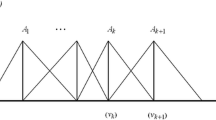Abstract
In this paper we discuss two techniques to reduce the size of the acoustic model while maintaining or improving the accuracy of the recognition engine. The first technique, demiphone modeling, tries to reduce the redundancy existing in a context dependent state-clustered Hidden Markov Model (HMM). Three-state demiphones optimally designed from the triphone decision tree are introduced to drastically reduce the phone space of the acoustic model and to improve system accuracy. The second redundancy elimination technique is a more classical approach based on parameter tying. Similar vectors of variances in each HMM cluster are tied together to reduce the number of parameters. The closeness between the vectors of variances is measured using a Vector Quantizer (VQ) to maintain the information provided by the variances parameters. The paper also reports speech recognition improvements using assignment of variable number Gaussians per cluster and gender-based HMMs. The main motivation behind these techniques is to improve the acoustic model and at the same time lower its memory usage. These techniques may help in reducing memory and improving accuracy of an embedded Large Vocabulary Continuous Speech Recognition (LVCSR) application.
Similar content being viewed by others
References
Aubert, X., Haeb-Umbach, R., & Ney, H. (1993). Continuous mixture densities and linear discriminant analysis for improved context-dependent acoustic models. In Proc. ICASSP’93, Minneapolis (Vol. II, pp. 648–651) 1993.
Chen, S., & Gopinath, R. A. (1999). Model selection in acoustic modeling. In Proc. Eurospeech’99, Budapest (pp. 1087–1090) 1999.
Garafolo, J., Lamel, L., Fisher, J., Fiscus, D., & Pallet, N. (1993). The DARPA TIMIT acoustic-phonetic continuous speech corpus CDROM, NTIS order number, PB91-100354.
Hernández-Ábrego, G., & Menéndez-Pidal, X. (2002). In Alternative approaches to acoustic modeling based on triphone clustering (Tech. Report SLT). SONY Electronics.
Hernández-Ábrego, G., Menéndez-Pidal, X., Kemp, T., Minamino, K., & Lucke, H. (2003). Automatic set-up for speech recognition Engines based on merit optimization. In Proc. ICASSP-2003, Hong Kong, 2003.
Hernández-Ábrego, G., Olorenshaw, L., Tato, R., & Schaaf, T. (2004). Dictionary Refinements based on Phonetic Consensus and non-uniform pronunciation reduction, Proc. ICLSP-2004, Korea, 2004.
Huang, X., Arikki, Y., & Jack, M. (1990). Hidden Markov models for speech recognition. Edinburgh: Edinburgh University Press.
Kats, W., Krippe, C., & Tallal, P. (1991). Anticipatory coarticulation in the speech of adults and children: acoustic, perceptual, and video data. Journal of Speech and Hearing Research, 34, 1222–1232.
Linde, Y., Buzo, A., & Gray, R. M. (1980). An algorithm for vector quantizer design. IEEE Transactions on Communications, COM-28, 84–95.
Liu, X., & Gales, M. J. F. (2003). Automatic model complexity control using marginalized discriminative growth functions. In Proc. 2003 ASRU workshop, St. Thomas, US, Virgin Island (pp. 37–42) 2003.
Ljole, A., Hindle, D., Riley, M., & Sproat, R. (2000). The AT&T LVCSR-2000 system. In Proc. 2000 speech transcription workshop, 2000.
Lucke, H., Honda, H., Minamino, K., Hiroe, A., Mori, H., Ogawa, H., Asano, Y., & Kishi, H. (2003). Development of a Spontaneous Speech Recognition Engine for an Entertainment Robot. In ISCA IEEE workshop on spontaneous speech processing and recognition, Tokyo (pp. 87–90) 2003.
Mariño, J., Pachès, P., & Nogueiras, A. (1998). The demiphone versus the triphone in a decision-tree state-tying framework. In Proc. ICSLP’98, Sydney, 1998.
Mariño, J., Nogueiras, A., Pachès, P., & Bonafonte, A. (2000). The demiphone: an efficient contextual subword unit for continuous speech recognition. Speech Communication, 32(3), 187–197.
Menéndez-Pidal, X., Chen, R., Wu, D., & Tanaka, M. (2001). Compensation of channel and noise distortions combining normalization and speech enhancement techniques. Speech Communication, 34(1–2), 115–126.
Pachès, P. (1999). Improved modelling for robust speech recognition. PhD Thesis Dissertation. http://gps-tsc.upc.es/veu/research/pubs/thesis.php3.
Young, S. J. (1999). Acoustic modelling for Large Vocabulary Continuous Speech Recognition, computational models of speech pattern processing. In Proc. NATO advance study institute (pp. 1–23). Berlin: Springer.
Young, S. J., Odell, J. J., & Woodland, P. C. (1994). Tree-based tying for high accuracy acoustic modeling. In Proc. human language technology workshop, Plainsboro, NJ (pp. 307–312). San Mateo: Morgan Kaufman.
Young, S. Y., Evermann, G., Hain, T., Kershaw, D., Odell, J., Ollason, D., Povey, D., Valtchev, V., & Woodland, P. (2002). The HTK book version 3.2. Cambridge: Cambridge University Press.
Zheng, J., Franco, H., & Stolcke, A. (2003). Modeling word-level rate of speech variation in a large vocabulary conversational speech recognition. Speech Communication, 41(2–3), 273–278.
Author information
Authors and Affiliations
Corresponding author
Rights and permissions
About this article
Cite this article
Menéndez-Pidal, X., Patrikar, A., Olorenshaw, L. et al. Development of the compact English LVCSR acoustic model for embedded entertainment robot applications. Int J Speech Technol 10, 63–74 (2007). https://doi.org/10.1007/s10772-008-9012-6
Received:
Accepted:
Published:
Issue Date:
DOI: https://doi.org/10.1007/s10772-008-9012-6




